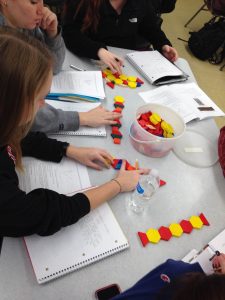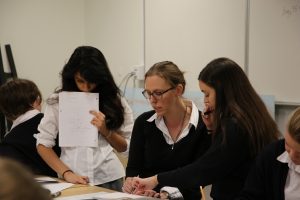Outside education, everyone assumes that it must be easy for teachers to measure our students’ learning. Just give them a test, right? As insiders, we know it isn’t this straightforward. Like @bnichols has pointed out in her recent posts, choosing a suitable assessment isn’t so easy, because tests don’t necessarily measure learning – they measure a very narrow skill set.
Exactly one year ago I embarked on some self-directed PD in a quest to find new ways to run my grade 11-12 math classes. I was interested in finding out what “inquiry” meant at this level of math education, and whether changing my classroom routine away from direct instruction could help improve student learning. I started by visiting the team behind Discovering the Art of Mathematics at Westfield State University.
 Inspired by their collaborative, discussion-based approach, I returned to class and immediately changed my grade 11 math course. We switched to a small-group format where students worked together on the content without my instruction. They thought and reasoned together as they developed their own understanding of concepts. I was exhilarated and scared at the same time: were they really able to construct enough meaning without me telling them what to do? These students take external 2-year comprehensive exams in grade 12 – would I put their exam performance in jeopardy?
Inspired by their collaborative, discussion-based approach, I returned to class and immediately changed my grade 11 math course. We switched to a small-group format where students worked together on the content without my instruction. They thought and reasoned together as they developed their own understanding of concepts. I was exhilarated and scared at the same time: were they really able to construct enough meaning without me telling them what to do? These students take external 2-year comprehensive exams in grade 12 – would I put their exam performance in jeopardy?
Nothing like a little risk to keep you on your toes, right? I gathered input from them during the unit as they adjusted to the new style (they loved it!), I had my principal come and observe and give feedback, and I started tracking the data on that oh-so-important measure of student learning: test scores.
While I enjoy the flexibility I have to assess in multiple ways in grades 9-10, and I make efforts to get students learning through projects in grade 11, I am aware that at the end of grade 12, their IB Diploma scores are 80% test-based. So their test-taking abilities are key to measuring up on the Diploma. And I’ve always wondered… wouldn’t they be fine on tests if they really understood the material?
One year in to this experiment, I am measuring its success. I have recently submitted a report to school leadership with the results of my attempts to shift into something more experiential for students: Experiencing active learning, but also experiencing the discussion and reasoning that leads to problem solving. This is the work of mathematicians. In the report I am pleased to note that in my grade 11 class, average test scores have increased by 20% on all tests. I haven’t changed the format or the style of questions – I have only changed the student experience in class.
 My class was recently recorded and I watched the video, hoping to find things to reflect on. I hate watching myself on film, but I was interested in seeing how the class played out from a different perspective. I saw some things I overlooked during class, and I wondered whether all the students were learning and thinking all the time. But then I asked myself: do I really believe that students who are quietly listening to a lecture are always actively thinking?
My class was recently recorded and I watched the video, hoping to find things to reflect on. I hate watching myself on film, but I was interested in seeing how the class played out from a different perspective. I saw some things I overlooked during class, and I wondered whether all the students were learning and thinking all the time. But then I asked myself: do I really believe that students who are quietly listening to a lecture are always actively thinking?
If I don’t believe that tests are the sole way to measure student learning, I can’t judge my own teaching by test results either. So test scores have increased by 20% on average. Is that enough to call my experiment in collaborative, discussion-based learning a success? Watching this video has helped me find another measure: student engagement. I watched as my students actively participated, supported, questioned, and reasoned with each other. In the video I saw these things in my classroom: respect, discussion, teenage distraction, patience, courage, and comfort. Was it a perfect lesson? No, but it was a typical one. If this video is a good indicator of how my classes are functioning one year into this experiment, I think I am ready to call it a success.

Well said! I couldn’t agree more. We have to do everything we can to help students develop the confidence to learn independently and collaboratively, and come to a proper understanding of how the teacher fits into their learning. An expert (the teacher) in the room is a valuable resource, but unless the students are engaged with the questions and problems at hand, they aren’t going to make proper use of that expert. By forcing students to actively puzzle together, they will realize that there is much that they can figure out themselves, and that the expert is but a resource for when they have reached the limits of their collective abilities.
Wow, @reicholtz – this is impressive. This takes a ton of guts to make such a substantial change. I was so glad to read that the students seemed to enjoy the change. How did you prepare them/sell them on it? Teachers at my school who have attempted similar (though not nearly as massive) changes have found they’ve met with a lot of resistance from students who have become conditioned to want to be told what to do, rather than think for themselves. Did you have similar resistance? And how did you manage it, if so?
Thanks for the comments @jweening! I have taught those classes of students who are resistant to change and just want to be told what to do. 2 or 3 years ago I could only manage occasional lessons that deviated from chalk-n-talk, before the students were tired of thinking and started complaining.
For this particular switch, I told them what I wanted to try, and that it would only be for one unit, and that we could go back to “normal” after the unit if they wanted. Giving them a voice made them willing to try. I valued their input and respected them as learners, and I think they felt that. In the end, they liked the new methods but asked for occasional direct instruction where it made sense. I thought this was a pretty reasonable request, and it is one I have stuck to.
Part of it is also training and school culture. For this year, I taught many of the same students last year, so they are already used to my expectations, which means I can push them even farther! 🙂